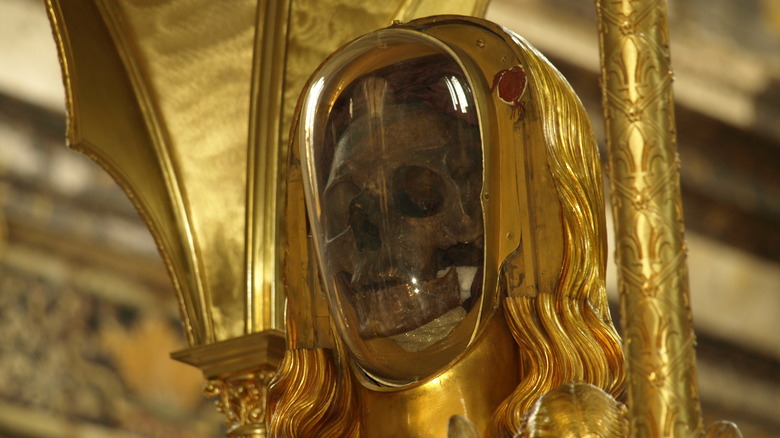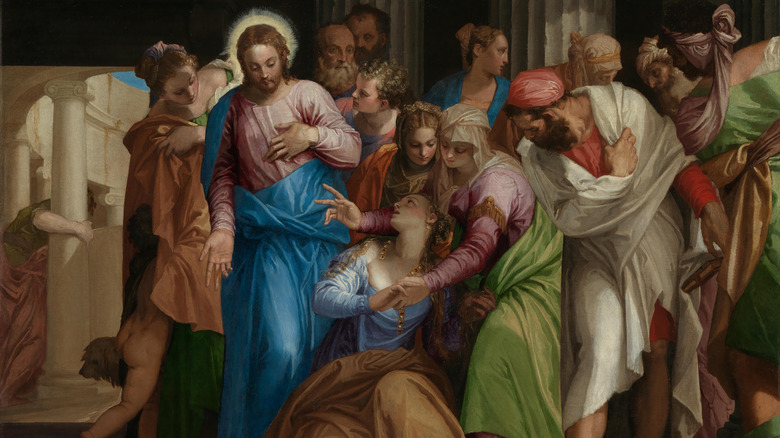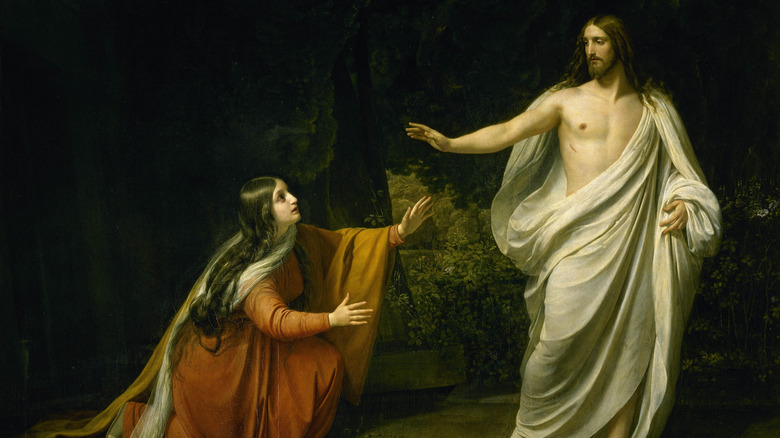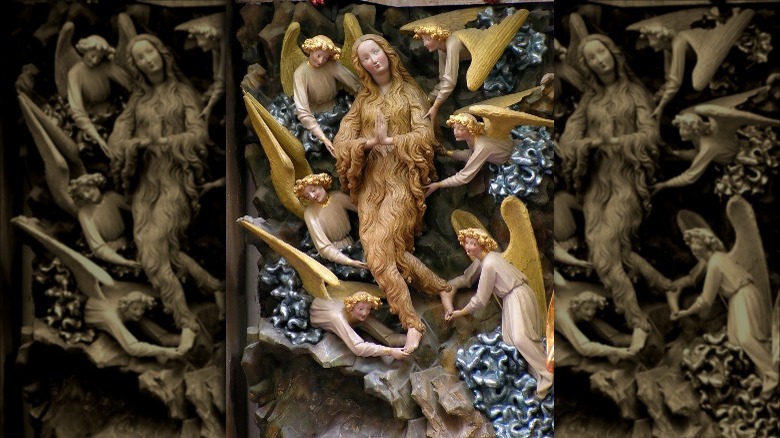Does The Bible Ever Mention Mary Magdalene's Death?
Mary Magdalene is, after the Virgin Mary, the most-named women in the Gospels, and was very clearly the most important of Jesus' female followers. For this reason, she has been a figure of both mystery and controversy since the very earliest days of the Christian church. There are ancient texts that claim she was the most important of all of Jesus' disciples, and there is no shortage of people today who believe that Jesus and Mary Magdalene were married. Books such as the novel "The Da Vinci Code" claim that they were married, had children, and their bloodline was preserved as the Merovingian line of Frankish kings, surviving secretly to the present day. She is commemorated as both a repentant sex worker and a saint, and many relics of her are on display in France, including her skull, which is contained in a human-shaped, glass-faced reliquary.
But how much of this information actually comes from the Bible? What do we really know of her life? One thing we know for sure is that the Bible never calls her a sex worker. The Gospel of Luke says that she was a follower of Jesus from whom he had driven out seven demons. As NPR explains, the idea of Mary as a sex worker dates to a homily of Pope Gregory I in the year 591, in which he conflated Mary Magdalene with Mary of Bethany and an unnamed "sinful woman" from Luke Chapter 7 (who is also never identified as a sex worker).
What the Bible really says about Mary Magdalene
But just because the Bible never assigns Mary Magdalene the profession with which she has been so long identified doesn't mean that it has nothing to say about her. Besides the fact that Mary Magdalene is mentioned more than any other female follower of Christ, she's also mentioned more than most of his male followers. Whenever Jesus' female disciples are named, Mary is always listed first, indicating her importance. The Gospel of Luke says that Mary was one of the women who supported Jesus financially, which has led some scholars to believe she must have been wealthy. "Mary," or its Hebrew equivalent "Miriam," was the most common name for women in Roman Judea, as will become clear to anyone trying to keep the women of the Gospels straight, and so this Mary is identified as the Magdalene, which isn't a last name, but – as King's College explains – suggests she was from the Galilean fishing village of Magdala.
All four Gospels agree that Mary Magdalene was a witness to Jesus'scrucifixion, and the Gospels of Matthew and Mark both specifically mention Mary Magdalene as a witness to the burial of Jesus. Perhaps most importantly, all four Gospels agree that Mary Magdalene, either alone or as part of a group, was the first to discover Jesus' empty tomb. The Gospel of John goes a step further in saying Mary was the first to see the risen Christ and the one who told all the other disciples about it, including Peter. Here, however, Mary's biblical narrative ends.
The apocryphal acts of Mary Magdalene
The end of a narrative within the canonical Gospels is rarely the end of the story for important — and often even tangential — figures in Christian literature. Christian writers in late antiquity would often take up the stylus to fill in some of the blanks about biblical figures such as the apostles, and Mary Magdalene in her developing role as "apostle to the apostles" was no exception. In a number of the texts written by the early Christian groups known variously as the Gnostics, though rejected as part of the canon of Scripture, Mary (not always identified explicitly as the Magdalene, but generally interpreted as such) appears as Jesus' most important disciple. In the eponymous 2nd century text the Gospel of Mary, the apostle Levi acknowledges that Jesus loved Mary more than all his other disciples and imparted to her a mystic vision apart from the others.
In the Gospel of Philip, composed around the same time, the text refers to Mary Magdalene by a term that could mean the companion or the wife of Jesus. It also says that Jesus "kissed her often on the" and then there's a very unfortunate blank spot in the manuscript. There's even a lost text called the Questions of Mary in which Jesus reveals to Mary alone the true — and too gross to repeat here — secret of salvation. These apocryphal texts are among those used by authors such as Dan Brown as evidence of the theory that Jesus and Mary were married, or at least lovers of some kind.
The legendary death of Mary Magdalene
The story of Mary Magdalene was further developed in late antiquity and the Middle Ages. As Encyclopedia.com explains, by very early in Christian history, Mary Magdalene was being conflated with Mary of Bethany, the sister of Martha and Lazarus, who washed Jesus' feet with her hair. The confusion of these two Marys and the "sinful woman" of Luke's Gospel led to the declaration of Mary Magdalene as a sex worker by the pope. Ultimately that was rescinded, but it still lingers in popular consciousness. The association of Mary Magdalene with sex work meant that she was later confused with another Mary, Mary of Egypt, who actually was a repentant sex worker who lived in the desert to atone for her life.
The fullest version of the life of Mary Magdalene, in which she is fully combined with Mary of Bethany and Mary of Egypt, comes from the 13th century text the Golden Legend by Jacobus de Voragine. In this version, Mary is extremely rich and lascivious, but gives up this life to follow Jesus. Some time after the crucifixion, she and her siblings Martha and Lazarus are sent out in a boat to die, but instead they land safely in southern France. Mary lives the last 30 years of her life as a naked hermit in a cave (with her hair growing out to maintain her modesty), sustained by angels. Finally a bishop comes to give her the Eucharist, at which point she lies down and dies.



